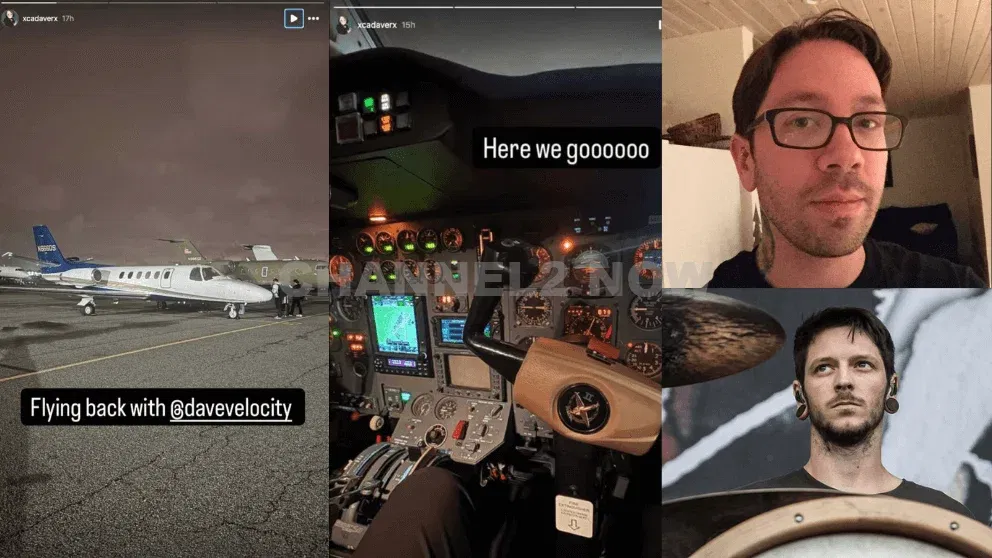Daniel Williams, the 39-year-old former drummer for the influential metalcore band The Devil Wears Prada, was one of the last people to publicly document the fateful hours leading up to a devastating plane crash in San Diego that has sent shockwaves through the music industry and beyond. Sharing images from the cockpit of a small aircraft just hours before the aircraft’s ill-fated descent, Williams appeared to be in high spirits. But by dawn, tragedy had struck. Among the confirmed fatalities is 42-year-old Dave Shapiro, co-founder of the music agency Sound Talent Group and a respected figure in the live music and artist representation community. While authorities have not yet formally identified all the victims, the chilling silence that followed Williams’ final Instagram stories has intensified fears that he was among those lost in the crash.
The incident, which occurred in the early morning hours of a Thursday, unfolded in the Murphy Canyon neighborhood of San Diego, a typically quiet residential area known for its proximity to military housing. According to officials, the plane crashed amid dense fog, obliterating several homes and vehicles, sparking fires that consumed at least 15 buildings, and forcing the evacuation of approximately 100 residents. As emergency responders navigated blinding weather conditions to contain the blaze and recover victims, the magnitude of the catastrophe became painfully clear.
A Final Glimpse: The Instagram Stories
Late Wednesday night, in what has now become an eerie and somber digital time capsule, Daniel Williams uploaded a series of Instagram stories that now serve as haunting artifacts of his final hours. One of the images captured him in the co-pilot’s seat of a small aircraft, captioned playfully with, “Hey. Hey… you… look at me…. I’m the (co)pilot now,” a tongue-in-cheek reference to a famous line from the film Captain Phillips. In another image, he tagged music agent and pilot Dave Shapiro, writing, “Flying back with @davevelocity,” a handle known to followers of Shapiro’s multifaceted life in the music and aviation worlds. The final image simply read, “Here we gooooo,” as Williams sat poised in the cockpit, bathed in artificial lighting against the dark canopy of night—completely unaware of the nightmare that lay ahead.
Social media has become a strange archive in the modern age, and in this case, it offered an intimate, time-stamped chronicle of what appeared to be a routine private flight. Williams’ posts brimmed with the casual confidence and joy one might expect from someone reunited with a friend or colleague, returning home from a trip or preparing for the next adventure. But within hours, that tone would be rendered tragically ironic.
Flight Path and Timeline
Flight tracking data confirms that the aircraft departed Teterboro Airport in New Jersey around 11:15 p.m. Eastern Time on Wednesday. Teterboro is a well-known hub for private aviation and corporate travel, located just 12 miles from Manhattan. The route from the East Coast to California is a frequent one for musicians and agents in the industry, often involving stops for refueling and rest due to the limited range of smaller aircraft.
In this case, the plane made a fuel stop in Kansas—an ordinary logistical necessity—before pressing onward toward its final destination in Southern California. The timeline of the journey appears to have been executed as planned until the final descent into San Diego. It was during these final moments that dense fog enveloped the area, creating highly dangerous flying conditions. While commercial airliners are generally equipped with advanced systems for low-visibility landings, smaller private planes are more vulnerable to weather anomalies, particularly in residential zones where there’s little room for error.
The Crash Site: Murphy Canyon in Chaos
Shortly after entering San Diego airspace, the aircraft encountered its fatal end in the Murphy Canyon neighborhood, a suburb flanked by a mix of civilian homes and military residences. The impact of the crash was catastrophic. According to Assistant Fire Chief Dan Eddy, the scene was as chaotic as it was dangerous. “You could barely see in front of you,” he said during a press conference, describing the low visibility and dense smoke that complicated initial response efforts.
The plane struck multiple structures, igniting fires that quickly spread across several residential properties. Emergency crews raced to contain the blaze, with more than 50 personnel dispatched to the area. Amid the confusion, residents scrambled to evacuate. Families, many of whom were still asleep when the crash occurred, had only minutes to react. Local reports confirm that approximately 100 residents were displaced by the disaster, and many now face the difficult task of rebuilding their homes and lives.
While officials have not provided detailed accounts of how many homes were destroyed outright versus partially damaged, the scale of destruction was evident in aerial footage captured by news helicopters: scorched rooftops, blackened debris, and the skeletal remains of formerly thriving homes now reduced to smoldering ruin.
The Victims: Confirmed and Feared
By Thursday afternoon, Sound Talent Group—a prominent booking and talent management agency co-founded by Dave Shapiro—issued a formal statement confirming his death. “We are devastated by the loss of our co-founder, colleagues, and friends,” the agency said. “Our hearts go out to their families and to everyone impacted by today’s tragedy. Thank you so much for respecting their privacy at this time.”
Dave Shapiro was more than just a booking agent; he was a linchpin in the rock and metal music communities. Known for representing an impressive roster of bands and organizing events that gave rise to some of the genre’s most iconic live performances, his death reverberates deeply among artists, promoters, and fans alike. His passion for music was rivaled only by his interest in aviation, a dual identity that ultimately intersected in the most tragic of ways.
As for Daniel Williams, the former drummer whose posts first alerted fans to the possibility of his involvement, no official confirmation has been released regarding his status. The absence of activity on his social media accounts since the crash has only deepened public concern. Tributes have already begun pouring in across online platforms, with fans and former bandmates expressing grief, hope, and disbelief in equal measure.
Williams had played a critical role in shaping the sound and energy of The Devil Wears Prada, a band that emerged in the early 2000s as a defining force in the metalcore genre. Known for his explosive drumming style and dynamic stage presence, Williams helped the group craft a unique sound characterized by a fusion of aggressive instrumentation and melodic undertones. Though he parted ways with the band in later years, his influence remained embedded in their identity.
The Investigation: FAA and NTSB on the Case
With the immediate aftermath focused on fire containment and rescue, the next phase of response now turns to investigation. The Federal Aviation Administration (FAA) and the National Transportation Safety Board (NTSB) have jointly launched an inquiry into the circumstances surrounding the crash.
At the center of their investigation will be several key questions: What type of aircraft was involved? Were there any mechanical failures reported? What role did weather play? Was the flight path properly managed? Did the pilot issue any distress signals? And most critically, what can be done to prevent a recurrence?
Because the crash occurred near a densely populated residential area, investigators will also need to examine protocols related to flight paths and the proximity of private aircraft to non-commercial zones. While it is not uncommon for small planes to fly over residential neighborhoods during takeoff and landing, the risks associated with doing so are now back under the spotlight.
Broader Implications: Music, Travel, and Safety
The tragic deaths of Dave Shapiro and the possible loss of Daniel Williams have sent ripples across two industries: music and aviation. In the world of touring musicians and agents, private flights are often a necessity rather than a luxury, given the relentless schedules and tight timelines of global performance circuits. Yet with every convenience comes heightened risk.
Small aircraft crashes, while rare, have disproportionately claimed the lives of public figures and artists in recent years. From musicians like Aaliyah to sports stars like Kobe Bryant, the recurring theme is one of devastating loss resulting from travel that was considered routine. These incidents raise persistent questions about the safety regulations governing private flights, the qualifications of pilots, the limitations of small aircraft, and the unique hazards of nighttime or fog-bound navigation.
For the families of those affected, no amount of data or statistical analysis can undo the horror of what has happened. Lives have been irreversibly altered. Communities, both local and professional, have been shaken. Fans who once watched their idols on stage or followed their every move online are now left with nothing but memories and mourning.
Mourning and Memorials
In the coming days and weeks, tributes are likely to take many forms—from candlelight vigils in Murphy Canyon to commemorative concerts in honor of the victims. Both Williams and Shapiro held places of respect and affection in their respective circles. The former was an artist, a performer who brought rhythm and intensity to thousands of live sets; the latter, a behind-the-scenes visionary who believed in the power of music to connect, inspire, and transform.
If Daniel Williams is ultimately confirmed among the deceased, the music world will have lost not just a drummer, but a voice from an era when metalcore reshaped the contours of heavy music. If he somehow survived, the path ahead will still be paved with grief—for his friend, for the lives lost, and for the trauma endured.
Conclusion: Unanswered Questions and Unfinished Stories
As authorities sift through the wreckage and families brace for confirmation, the story of the San Diego plane crash remains unfinished. We know some of the who, some of the where, some of the how. But much is still obscured—by fog, by fire, and by the cruel speed at which tragedy strikes.
What began as a seemingly ordinary flight—punctuated by laughter, camaraderie, and digital snapshots of joy—ended in devastation. And now, the challenge for investigators, survivors, and loved ones alike is to understand, to mourn, and eventually, to heal.
For now, a community waits. For names. For answers. For peace. And in the stillness left behind, the memory of Daniel Williams’ final post—“Here we gooooo”—echoes with a poignancy no one could have predicted.


Leave a Reply